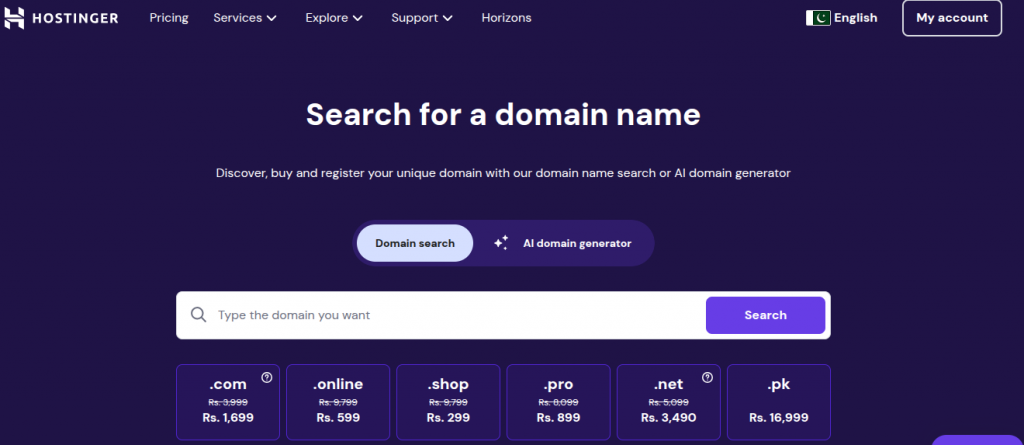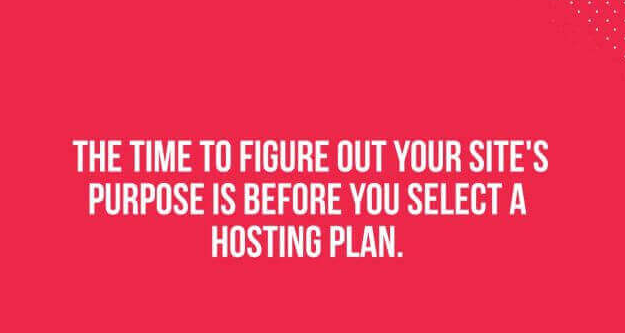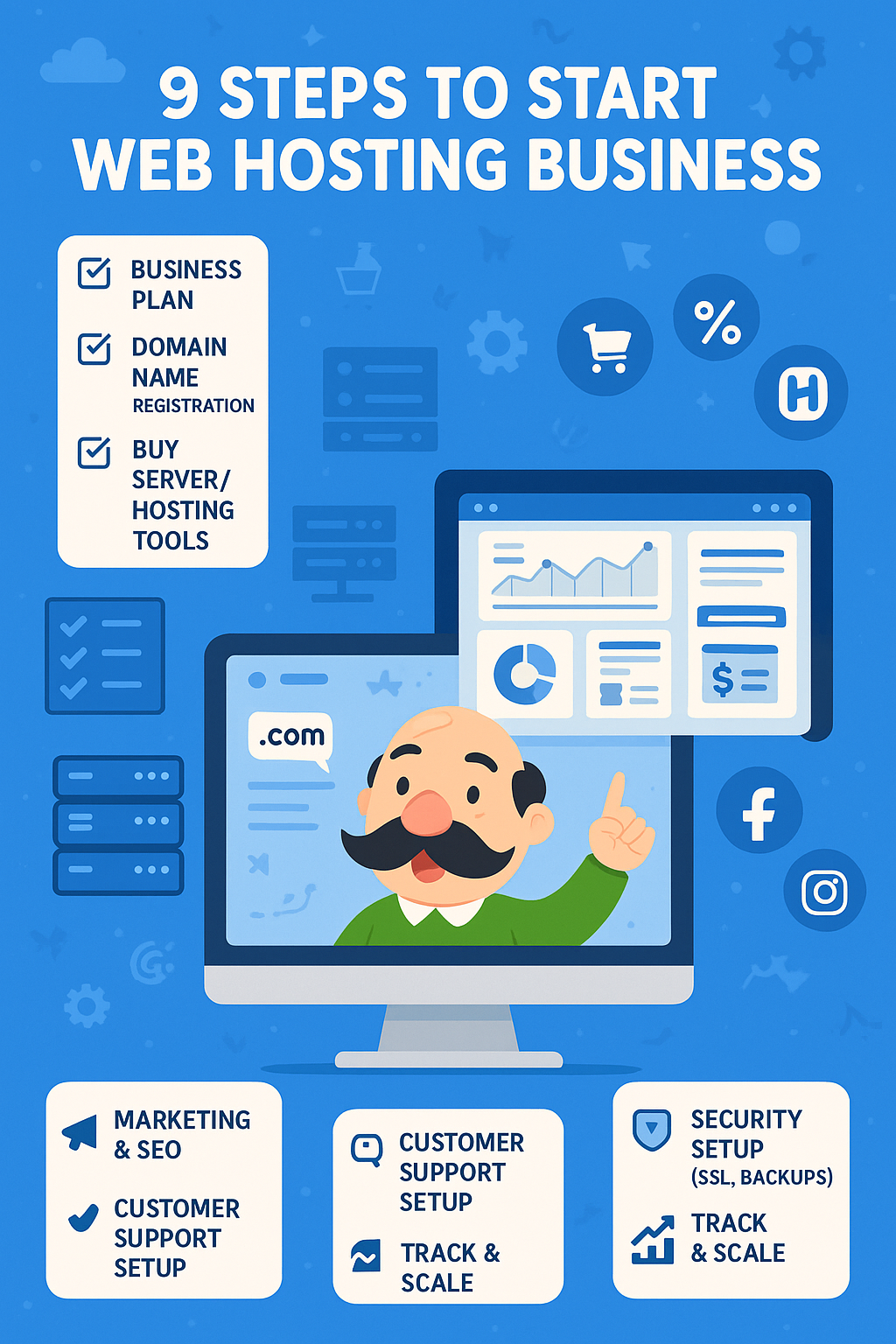Starting a web hosting business may seem simple, but it takes more than just a basic setup to succeed. I remember launching my own company with almost no budget — it was surprisingly cheap, yet taught me the value of providing reliable services. With every individual and business needing websites, there’s real room to grow, even in a space full of competition.
My first few clients brought significant returns, showing how safe and easy it can be to scale if done right. You must focus on generating value and supporting your clients as they grow — that’s where you’ll see the long-term rewards.
When I launched my web hosting business, it opened new revenue streams and helped me serve more clients with essential services. If you already run a company in IT, infrastructure, or design, adding a hosting platform supports sustainable growth and attracts upcoming businesses. It’s a smart way to offer valuable products while building strong connections and helping others get started in the digital space.
Do I have to be tech-savvy?
When I first launched my website, I had no prior experience and the process felt like climbing a mountain. But with the help of a builder offering a drag-and-drop editor, things became easier. I didn’t need to learn HTML, CSS, PHP, or JavaScript—the platform handled it all without code.
You can create a new, fully functional web-oriented site, even if you’re just starting with basic knowledge, and everything gets done visually—like creating blocks with purpose.
You don’t need to be highly tech-savvy to start a hosting business. Platforms like WordPress, Joomla, or Drupal make it easy to manage a website without deep technical skills. I started from scratch with just a passion to learn — having control over your setup, like sitting in the driver’s seat, gave me the confidence to grow.
Being in complete control helps you achieve better results, and tools today let you easily position your business ahead of the competition. In my experience, even without formal training, you can put things in place and move yourself forward. It’s not about being a pro, just knowing your way around the platforms.
With time, you’ll learn what yields the best outcome and what doesn’t. It’s not a negative to start with little knowledge — it’s just another instance where you learn as you go. All you need is the will, the right tools, and a mindset to do better than others. Trust your gut, stay consistent, and be ready to stand against the odds.
When I started my small business, I wasn’t sure if I had to be a tech genius. The truth is, even if you’re not deeply technical, you can still create a simple website that displays your products and a blog without too much hassle. All I needed was to know how to choose a reliable web hosting provider, pick a domain name, and upload my files to the internet.

Most of the time, user-friendly platforms guide you through the process, so you don’t feel lost. My advice? Focus on the projects you care about, use tools that do the heavy lifting, and take it step-by-step. If your goal is to get your content on the web, you only need to know the basics—to get your site on the web and grow your business from there.
Identify Your Site’s Objective
When I first creates a website for my small business, I didn’t realize how much the site would play a role in growth. Many new owners either underestimate or overestimate what they need, which can lead to paying for a hosting plan that’s either too basic or too advanced. It’s common to think you’ll need more from your hosting service early on, but the result is often a quick upgrade in just a few months, or worse, spending on a level of support you never use.
You should determine your site’s purpose before choosing a hosting plan.
Before launching my web hosting business, I realized that every site has unique requirements. A blog or promotional website might only need simple pages, while an eCommerce store with thousands of products demands more storage, databases, and a powerful server.
Whether you’re targeting traffic to a brick-and-mortar location or staying fully online, offer flexible plans with strong features to support retail, catalogue needs, and secure saving.
Blogs with lots of videos or images need more server resources than those with just a few text posts.
Before starting my web hosting journey, I had to determine how the site would function in my business. Choosing the right packages, rates, and resources meant considering factors like server, storage, and bandwidth. The intended use of the website guided all decisions and steps in creating a solid plan with trusted providers.
Choose the Best Hosting Plan
In a competitive marketplace, many companies are vying to be your go-to hosting provider. Focus on technology, monthly rates, and customer service—these factors truly help your business grow. Always choose a provider with strong differentiators that meet your customers’ needs and feel right for you.

Here are the things you should look for when choosing a web hosting plan:
- The hosting company should offer different plans so you can pick one that fits your needs.
- Getting your hosting up and running should be free with no setup costs.
- Some web hosting providers include a free domain name with every hosting plan. Even though the cost is small, getting a free domain is always a nice bonus.
- The provider should include free tools to build your website and a control panel to manage it easily.
- Well-known CMS platforms like WordPress should be fully supported.
- Hosting plans should run on high-performance servers to guarantee reliable website performance.
- Customer support should be available through email and phone, preferably 24/7.
- A simple website builder should be available so you can try creating pages and build your first website easily .
Starting a web hosting business means offering affordable, reliable options that meet various business needs. Many clients begin with shared hosting, where multiple websites run on one system and share server resources. But as traffic grows, so does the need for performance, security, and access.
That’s when VPS or Virtual Private Server solutions shine—providing fast, custom, and enhanced support without the high cost of dedicated servers.
Plans should include features like domain and email addresses, support for multiple sites, and disaster recovery tools. Avoiding limitations and restrictions is key for growing websites.
Offering flexible plans with options like Private setups, protection from malicious intent, and helpful guides or blogs helps clients opt for what fits best. Always be ready to help owners make smart choices and scale with ease.
Buy a Domain for Your Website
When I started my own hosting business, the first crucial part was securing a strong domain and name. Although it’s deeply associated with your website, this connection isn’t permanent—you can transfer it later if you desire a different direction or rebranding.
A domain name is like giving your website an easy-to-remember name, so people don’t have to deal with confusing number strings like IP addresses.

When I created my first website, I knew the domain and name needed to match my brand and reflect its digital identity. A unique IP address marks your site on the internet, but people remember words, not numbers.
I always recommend choosing a memorable, right name — it’s more than a technical task, it’s your online presence. With just a bit of pairing and planning, I made sure mine was marked, easy to type, and truly crucial for my business.
From my own experience, when you purchase a domain, make sure it’s relevant, short, and professional. Over time, I bought a different domain to reflect a business pivot — and with a simple redirect, I kept all the SEO value while rebranding smoothly.
It’s incredibly easy to connect a new name to your existing website, especially if your hosting provider supports seamless redirection.
Once your domain is associated with your site, it becomes the foundation of your online presence. Whether you’re just getting started or planning for future updates, always keep your address, created assets, and overall name strategy aligned.
Your official online identity should evolve with your business, not against it — and getting this step right means you’re building your web hosting venture on solid digital ground.
When I first started my business, I quickly realized how important a solid domain name is for building credibility. While platforms like WordPress and Squarespace offer a free subdomain such as yoursite.wordpress.com, they often don’t look professional to potential clients.
That’s why I chose to invest in a custom domain—it made my website stand out and showed I was serious about what I was doing. The right name is not just a label; it’s a statement. It gives your own brand a face and helps you get taken more seriously, especially when you’re up against other companies in the same space.
I spent time shaping my idea, made a substantial decision to purchase the domain, and treated it as part of my long-term investing strategy. The result? A stronger foundation that truly reflects my goals and commitment.
Determine which CMS to use
When I first decided to start my web hosting business, I quickly realized it’s not enough to just use a CMS like WordPress — you need to buy a domain, manage your website, and avoid doing everything manually with HTML, CSS, and custom scripts.
A content system makes the process much more advisable and helps you stay focused on what really matters: building a powerful web presence using professional tools and structured contents.
This powerful open-source platform is highly flexible, capable of running everything from personal blogs to full-scale online stores, and can be easily optimized for search engines using a variety of helpful plugins.
When starting your website, choosing the right CMS or builder like Wix helps you create and manage a professionally designed site with good-looking templates that work on all devices.
With excellent options, even those with no experience can succeed. A famous example might suit all, so choose what fits best. You’ll learn more as you go, and it’s enough to begin—even without knowing everything. Stay looking ahead.
Website builders come with built-in search engine optimization features, allowing you to focus entirely on creating your content.
When I started my web hosting business, one of the first key decisions was choosing which CMS to support. I explored various platforms like WordPress, Drupal, and Joomla, each offering different levels of performance and flexibility.
For small business owners and bloggers, WordPress stood out because it was much easier to manage and quick to launch websites. However, as I worked with more notable companies and enterprise clients, I realized that Drupal and Joomla had the edge in handling complex content, custom sites, and large-scale eCommerce setups.
Many clients already owned their preferred system, but understanding their unique needs helped me guide them better. Being able to work across such a wide range of worldwide clients and industries meant I had to stay adaptable and deliver reliable solutions through the right CMS choices.
Starting a web hosting business means picking the right CMS and package for high performance. A managed platform like WordPress offers built-in security, monitoring, and fast load speeds. You’ll expect reliability, safe data, and strong capabilities from optimized servers. Be sure to choose smart, as the plan you have can mean the most for you.
Set Up Your Site Design
When I first started building websites, I learned that design isn’t just about looking good — it’s about creating a functional and attractive experience that keeps visitors coming back. As a novice, I made the mistake of choosing wild fonts and clashing colour schemes, which made the site look unprofessional.
Over time, I realized a well-thought-out website should reflect your brand, work right, and help you engage with your audience. As a website owner, understanding how the digital world works helped me avoid common pitfalls and focus on the little things that make a big difference, like keeping the layout clean and the flow intuitive, encouraging users to return.
Select a Theme
When I started my own web hosting venture, choosing the right theme was key. A professional layout with a clean design helped build trust. I made sure the banner and image placement fit the brand style, and the size didn’t slow down the site.
Using a CMS or builder made it easier to manage the website appearance, from fonts and text to the colour scheme, giving my site a sharp, polished look. I always recommend customizing the elements and location of content when designing, even if you’re using a premade template.
The Astra theme is a free and widely used WordPress theme known for its speed and flexibility. You can easily customize it to build any kind of website you want.
The Spectra page builder plugin adds extra flexibility by providing custom building blocks with a variety of engaging features.
Build an Eye-Catching Page Structure
When I first started building web hosting sites, I realized how important it is to keep the layout clean and focused. A strong structure and intuitive hierarchy help visitors feel at ease and find what they need quickly. Your store’s top section should showcase products clearly with a clear call to action. This is especially important if you’re trying to boost conversion on an ecommerce platform.
The design should support both usability and visibility, ensuring that content is both attractive and easy to readable. I like to start by choosing a flexible theme that allows me to customization features like colour, fonts, and typography. These may sound small, but each plays a big part in your overall scheme. Don’t forget the basics—your responsibility is to stay within certain boundaries so users can navigate your content with ease.
Use text blocks that match your brand’s voice and offer real value. Modify and steer the action toward what matters: signups, sales, or learning more. Appear more professional by using a well-designed interface. When you build your page, plan for every section—even if it’s just a some minor detail. Always know where you want your owner or customer to go next. Trust me, getting this right makes all the difference.
That’s why I recommend you always test and refine your default settings, whether it’s a CTA, online form, or product layout. And if you’re thinking, “Do you really need to care this much?” — you’ll thank yourself later. Start with a fundamental structure and build up with purpose. Use your tools responsibly, and always design with your user in mind. It’s your chance to make that strong first impression.
Mobile-Friendly Design
When I first launched my own hosting service, I quickly learned how important it is to think about users who browse on phones, tablets, and other devices. A site that isn’t mobile-friendly will instantly lose access to a huge audience. That’s why I always focus on responsive layouts that display content differently based on the device being used.
To make your site stand out, ensure there’s only one version of your design that adapts well. It should feel smooth and intuitive, regardless of screen size. You must strive to make it simple for people accessing your platform anytime, anywhere — because the way people connect has evolved, and your content must follow.
Publish Content on Your Website
When launching your web hosting business, publishing content on your site with the right structure is key. From personal experience, using a CMS makes it easier, especially if you’re not ready to dive knee-deep into HTML and CSS code.
I once opted for a manual route and quickly realized how important it is to design and plan before uploading anything. A well-designed, proper setup helps avoid going back to fix things, saving time and headaches. Every word and layout decision should be important, because these early decisions shape how your customers see your brand.
- If you run a blog, should you organize your posts by date or by topic?
- What is the best way to organize product pages in an online store?
- How can you make your FAQ or Privacy Policy page accessible, but only visible when needed?
Answering questions like these will help determine the most effective structure for your site’s content.
When I launched my first web hosting venture, I underestimated the power of content. It’s not just about filling space — your site should represent your brand with a voice that feels familiar and trustworthy. Clear messages, delivered with consistent tone, help visitors quickly understand your business and what sets you apart.

Think from the user’s perspective: they arrive looking for reliability and professionalism. What you communicate must reflect your values and handle concerns before they’re even voiced. This is your opportunity to build connection and trust through solid structure and storytelling.
Set Up Helpful Plugins
When I launched my first web hosting site, I quickly learned how vital plugins and add-on tools are to streamline management and improve your website’s functionality. Whether you’re using a popular CMS or a homegrown setup, integrating the right applications can truly extend your service capabilities.
Start by exploring feature-rich tools that match your niche — from helper scripts to security systems — and make sure they’re tied into your platform. I always choose options that are not just powerful but also easy for clients to use. With so many categories out there, you’ll find what fits — from content control to site backups.
Don’t ignore the significantly growing demand for smooth UI and smart automation. You can employ these tools to handle called tasks like auto-setup and billing. The right setup lets you support every, any, or most clients without getting overwhelmed.
Even if you’re building something similar to others, use what you know, test what your users need, and customize what you can. If you’re wondering where to begin — just pick one plugin and go from there. You’re not in this alone — another web host has likely faced your challenge before — and that’s the beauty of open tools: they’re for everyone, and built to help you scale to more.
Capture audience
When I first decided to build my own website, the most important step was choosing the right domain to set my site apart. A good domain helps your visitors connect instantly, especially when your design is clean, attractive, and easy to remember. Before anything else, I made sure the site was running smoothly and up 24/7, as this builds trust and encourages people to stay longer.
I’ve found that a simple, well-structured platform can quickly turn visitors into loyal customers, especially when you attract them with a professional look. If you can generate interest early, you’ll notice more engagement and leads. That’s why I always suggest to buy a domain that feels meaningful, is easy to remember, and reflects your purpose clearly. Every little detail counts, from the steps you take early on to the effort you put into making your online presence strong.
The list below outlines common methods for increasing the number of visitors to your website.
Grow Your Brand on Social Media
When I started my own hosting venture, I quickly realized how powerful social media is for building visibility. Platforms like Instagram, Twitter, and Facebook helped me connect with real people in the world who needed hosting, even before they searched on Google. Sharing regular posts with my profile link and adding a direct path back to my website made my business feel more present and professional.
I used platforms that fit my target audience. If you’re a creative like a make-up artist, you’ll shine on Instagram, but if you’re going after professionals, LinkedIn might be your space. I kept my content featured and prominently shared with the right reach in mind.
It’s not just about being online—it’s about being visible with strategy and tactic. A proven way to stand out is showing up daily, staying part of the conversation, and using platform tools smartly.
Once you start doing this, your brand becomes part of a bigger web of influence. That’s how I grew my business—by choosing the right platforms, building audience trust, and staying consistent, not just with what I posted, but also when I posted.
Focus on seo
When I first launched my web hosting venture, I underestimated how important SEO, or search engine optimization, would be for getting real organic traffic. To attract the right audience to your site, you need to craft content packed with relevant, semantic keywords that align with user intent and high-value queries. I learned to avoid stuffing or overuse, as that hurts readability and triggers penalties from Google’s algorithm. Instead, I focused on contextual placement—putting phrases into natural text, optimizing metadata, headings, and anchor tags with a healthy density of high-volume, competitiveness-balanced terms.
Another tip that helped boost my ranking on SERPs was understanding indexing and crawl behavior, ensuring my descriptions, on-page structure, and positioning all improved visibility. As I refined my strategy, I noticed how even updates to engine behavior or changes in searcher habits could affect results, so adapting content and staying discoverable became second nature. The right strategy, supported by clear focus and a balanced use of keywords, helped increase engagement and kept my platform ranked well in a competitive space.
Build high-quality backlinks
In my early days, earning backlinks from high-authority websites helped my site appear trustworthy. I made sure to include well-placed links from external sources to bring visitors and boost ranking on search engines. When another site links to you, it plays a significant role in your growth. You must have authority, target the right audience, and not overlook those details — they’re key if you want to truly stand out.
Communicate with a Steady and Clear Brand Tone
Keeping your message clear and steady helps give visitors a smooth, connected experience and builds a stronger presence for your brand online. Whether someone finds you through a social media post, a backlink, or an ad, they expect the same value and tone when they land on your site.
Implement Billing and Support Systems
When I launched my hosting business, setting up automated billing was a game-changer. Using integrated software and trusted payment tools like PayPal helped manage invoices, improved cash flow, and simplified account setup with seamless provisioning. A strong support structure with a ticket system, 24/7 assistance, and a dedicated desk ensured clients always had help. With a solid CRM, I could track user activity, respond fast, and offer personal, efficient service—building trust through real-time communication and smooth management of subscriptions, processes, and tools like the hosting panel.
FAQS
Start web hosting business from home and earn money?
Yes, you can start a web hosting business from home with low investment and earn good money. All you need is a strong plan, internet, and a reliable reseller hosting provider. Stay dedicated, build trust with clients, and grow step-by-step.
How to start a game server hosting business?
You can start a game server hosting business from home with the right strategy and tools. Focus on a strong foundation—choose popular games, reliable hardware, and know your market. Stay dedicated, follow a step-by-step plan, and keep building trust to see real results.
How to start a VPS hosting company?
You can start a VPS hosting company by first building a solid foundation with strong servers and virtualization tools. Study the market, set clear goals, and craft a smart strategy. Stay dedicated, grow step-by-step, and always review your progress. Earning trust brings lasting results.
conclusion
Building a web hosting business taught me that success comes from a solid foundation and clear goals. At the start, I focused on understanding the market and shaping my strategy to fit real needs.
Being dedicated every day helped me stay on track, even when challenges came up. I followed a step-by-step process and stuck to my plan, adjusting it with each new result I got.
The key is to build trust—with customers and with yourself. Always review your actions, learn from mistakes, and improve slowly but steadily.
Every part of this journey matters. If you keep showing up, your hard work will lead to success in the web hosting world.

